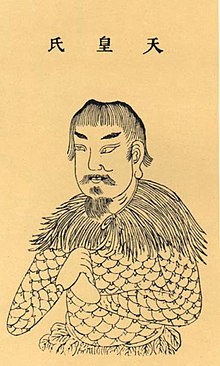Heavenly Sovereign

The Heavenly Sovereign (Chinese: 天皇; pinyin: Tiānhuáng) was the first legendary Chinese king[1] after Pangu's era. According to Yiwen Leiju, he was the first of the Three Sovereigns.
Name
[edit]The book Lushi from the Song Dynasty records that his family name was Wang (望, meaning "to observe" or "day or night of the full moon"), his given name Huo (獲, meaning "to hunt or catch"), and his courtesy name Zirun (子潤, run means "wet" or "wealthy", so "prosperous descendants").[2]
Biography
[edit]According to the "Basic Annals of the Three Sovereigns" (三皇本紀) in Sima Zhen's supplement to the Records of the Grand Historian:[3]
- After Heaven and Earth were formed, there was Tiānhuáng, who had twelve heads.
- The king was said to have an unselfish personality(or in a calm state or living in retirement) that even if he did not try to help the people, people's customs changed for the better.(澹泊無所施為,而民俗自化)
- And, Tiānhuáng was a king of many achievements, and was the king ruling under the influence (de) of the wood element (木德王). He lived to 18,000 years old. His twelve children supported him in reigning the world.
- His greatest achievement was suppressing all the chaos, dividing the world for the many tribes, and choosing the best people to rule the tribes.
His successor was the Earthly Sovereign.
According to the Yiwen Leiju,
- Based on Shixue (始學) by Xiang Jun, after the heaven and earth were formed, there was the Heavenly Sovereign, with 13 heads(or 13 leaders). He was called Tianling (天靈, 'heavenly spirit') and ruled the world for 18,000 years.
- Based on Dongming Ji (洞冥記, title means "Records of everything about the ghosts"), there were 13 people with the same family name.
- Based on the records in the Three Five Historic Records (三五歷紀) by Xu Zheng, when history began, life started to exist, and there was a divine spirit that had 13 heads called Tianhuang.
- Based on Chunqiu Wei (春秋緯), there were Heavenly, Earthly and Heavenly Sovereigns, they had 9 brothers and divided the world into the Nine Provinces, which spanned the world.
- Based on Dunjiakaishan Tu (遁甲開山圖), the emperor's remains are said to be under the Kunlun in Zhuzhou (柱州).
See also
[edit]References
[edit]- ^ "Ssŭma Ch'ien's Historical Records, Introductory Chapter". Journal of the Royal Asiatic Society. 26 (2). Translated by Allen, Herbert J.: 269–295 1894. doi:10.1017/S0035869X00143916. S2CID 161670530.
- ^ "路史卷二". ctext.
- ^ Sima Zhen. 補史記 (Supplement to the Records) (second-to-last paragraph)
Text is available under the CC BY-SA 4.0 license; additional terms may apply.
Images, videos and audio are available under their respective licenses.
